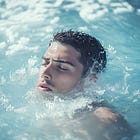Cold Water Immersion Did Not Improve Recovery After Hard Exercise
And it may not provide the benefits often claimed.
Does cold water immersion (CWI) really speed up recovery and improve performance after intense exercise? Many use CWI hoping it reduces muscle soreness and fatigue, but this research specifically investigates its effect on neuromuscular recovery after high-intensity interval exercise (HIIE) of the ankle dorsiflexors.
PMID: 40318171
Key Points
Aim
The primary goal was to determine whether a 10-minute cold water immersion at 10°C applied immediately after a bout of high-intensity interval exercise could accelerate the recovery of neuromuscular function, especially focusing on prolonged low-frequency force depression (PLFFD). This is a key factor in muscle fatigue and weakness after intense exercise. The study also examined whether CWI improves next-day exercise performance.
Methods
Participants: 12 healthy, recreationally active young adults (10 males, 2 females), average age 23.3 years.
Exercise Protocol: Participants performed six sets of 30-second all-out isokinetic concentric contractions of ankle dorsiflexors and plantar flexors.
Interventions: Immediately post-exercise, participants underwent either:
10 minutes of cold water immersion at 10°C (CWI), or
10 minutes of rest at room temperature (RT).
Measurements: Neuromuscular function was assessed at baseline, immediately post-exercise, and at 0.5, 1, 3, and 24 hours post-intervention. Key measures included maximal voluntary contraction torque, voluntary activation, and electrically stimulated torque at 10 Hz and 50 Hz frequencies to assess PLFFD and muscle fatigue. Intramuscular temperature was also monitored.
Next-day Performance: Participants performed a repeat HIIE bout 24 hours later to assess fatigue resistance and performance recovery.
Results
Both CWI and RT conditions showed impaired maximal voluntary contraction torque for up to 3 hours post-exercise, with no significant differences in voluntary activation between conditions.
Electrically stimulated torque at 10 Hz (low frequency) remained impaired up to 3 hours in both conditions, indicating persistent PLFFD.
The 50 Hz torque (high frequency) recovered within 1 hour after RT but remained slightly reduced for up to 3 hours after CWI.
The 10:50 Hz torque ratio, an indicator of PLFFD, showed immediate recovery with CWI but was delayed with RT. However, this did not translate into improved muscle function or performance.
Importantly, next-day HIIE performance (fatigue resistance, peak velocity, peak torque) was similar regardless of whether participants had CWI or RT post-exercise.
Practical Takeaways
Cold water immersion at 10°C for 10 minutes does not enhance recovery of muscle strength or reduce fatigue following high-intensity interval exercise of the ankle dorsiflexors.
CWI does not improve next-day exercise performance after such intense bouts.
While CWI may alter some neuromuscular parameters acutely (like the 10:50 Hz torque ratio), these changes do not translate into meaningful functional recovery benefits.
Recovery strategies should consider that CWI might not be effective for improving muscle contractile function or performance after high-intensity interval training, at least for small muscle groups like the dorsiflexors.
Athletes or recreational exercisers should weigh the use of CWI against other recovery methods, especially if the goal is to improve next-day performance.









